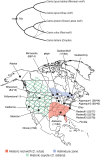Whole-genome sequence analysis shows that two endemic species of North American wolf are admixtures of the coyote and gray wolf
- PMID: 29713682
- PMCID: PMC5919777
- DOI: 10.1126/sciadv.1501714
Whole-genome sequence analysis shows that two endemic species of North American wolf are admixtures of the coyote and gray wolf
Abstract
Protection of populations comprising admixed genomes is a challenge under the Endangered Species Act (ESA), which is regarded as the most powerful species protection legislation ever passed in the United States but lacks specific provisions for hybrids. The eastern wolf is a newly recognized wolf-like species that is highly admixed and inhabits the Great Lakes and eastern United States, a region previously thought to be included in the geographic range of only the gray wolf. The U.S. Fish and Wildlife Service has argued that the presence of the eastern wolf, rather than the gray wolf, in this area is grounds for removing ESA protection (delisting) from the gray wolf across its geographic range. In contrast, the red wolf from the southeastern United States was one of the first species protected under the ESA and was protected despite admixture with coyotes. We use whole-genome sequence data to demonstrate a lack of unique ancestry in eastern and red wolves that would not be expected if they represented long divergent North American lineages. These results suggest that arguments for delisting the gray wolf are not valid. Our findings demonstrate how a strict designation of a species under the ESA that does not consider admixture can threaten the protection of endangered entities. We argue for a more balanced approach that focuses on the ecological context of admixture and allows for evolutionary processes to potentially restore historical patterns of genetic variation.
Keywords: Admixture; canids; genomics.
Figures




Comment in
-
Comment on "Whole-genome sequence analysis shows two endemic species of North American wolf are admixtures of the coyote and gray wolf".Sci Adv. 2017 Jun 7;3(6):e1602250. doi: 10.1126/sciadv.1602250. eCollection 2017 Jun. Sci Adv. 2017. PMID: 28630899 Free PMC article.
Similar articles
-
Genetic diversity and family groups detected in a coyote population with red wolf ancestry on Galveston Island, Texas.BMC Ecol Evol. 2022 Nov 14;22(1):134. doi: 10.1186/s12862-022-02084-9. BMC Ecol Evol. 2022. PMID: 36376792 Free PMC article.
-
A Genome-Wide Perspective on the Persistence of Red Wolf Ancestry in Southeastern Canids.J Hered. 2020 May 20;111(3):277-286. doi: 10.1093/jhered/esaa006. J Hered. 2020. PMID: 32090268
-
Tracing Eastern Wolf Origins From Whole-Genome Data in Context of Extensive Hybridization.Mol Biol Evol. 2023 Apr 4;40(4):msad055. doi: 10.1093/molbev/msad055. Mol Biol Evol. 2023. PMID: 37046402 Free PMC article.
-
Geography and recovery under the U.S. Endangered Species Act.Conserv Biol. 2010 Apr;24(2):395-403. doi: 10.1111/j.1523-1739.2009.01435.x. Epub 2010 Feb 11. Conserv Biol. 2010. PMID: 20151988 Review.
-
Red Wolf (Canis rufus) Recovery: A Review with Suggestions for Future Research.Animals (Basel). 2013 Aug 13;3(3):722-44. doi: 10.3390/ani3030722. Animals (Basel). 2013. PMID: 26479530 Free PMC article. Review.
Cited by
-
Dog10K: the International Consortium of Canine Genome Sequencing.Natl Sci Rev. 2019 Jul;6(4):611-613. doi: 10.1093/nsr/nwz068. Epub 2019 May 29. Natl Sci Rev. 2019. PMID: 31598382 Free PMC article. No abstract available.
-
Studies of wolf x coyote hybridization via artificial insemination.PLoS One. 2017 Sep 1;12(9):e0184342. doi: 10.1371/journal.pone.0184342. eCollection 2017. PLoS One. 2017. PMID: 28863171 Free PMC article.
-
From STRs to SNPs via ddRAD-seq: Geographic assignment of confiscated tortoises at reduced costs.Evol Appl. 2022 Aug 31;15(9):1344-1359. doi: 10.1111/eva.13431. eCollection 2022 Sep. Evol Appl. 2022. PMID: 36187190 Free PMC article.
-
Species delimitation, discovery and conservation in a tiger beetle species complex despite discordant genetic data.Sci Rep. 2024 Mar 19;14(1):6617. doi: 10.1038/s41598-024-56875-9. Sci Rep. 2024. PMID: 38503840 Free PMC article.
-
Considering Pleistocene North American wolves and coyotes in the eastern Canis origin story.Ecol Evol. 2021 Jun 5;11(13):9137-9147. doi: 10.1002/ece3.7757. eCollection 2021 Jul. Ecol Evol. 2021. PMID: 34257949 Free PMC article.
References
-
- R. M. Nowak, Evolution and taxonomy of coyotes and related Canis, in Coyotes: Biology, Behavior, and Management, M. Bekoff, Ed. (Academic Press, New York, 1978), pp. 3–16.
-
- Chambers S. M., Fain S. R., Fazio B., Amaral M., An account of the taxonomy of North American wolves from morphological and genetic analyses. N. Am. Fauna 77, 1–67 (2012).
-
- Wayne R. K., Jenks S. M., Mitochondrial DNA analysis implying extensive hybridization of the endangered red wolf Canis rufus. Nature 351, 565–568 (1991).
-
- Roy M. S., Geffen E., Smith D., Wayne R. K., Molecular genetics of pre-1940 red wolves. Conserv. Biol. 10, 1413–1424 (1996).
-
- vonHoldt B. M., Pollinger J. P., Earl D. A., Knowles J. C., Boyko A. R., Parker H. G., Geffen E., Pilot M., Jedrzejewski W., Jedrzejewska B., Sidorovich V., Greco C., Randi E., Musiani M., Kays R., Bustamante C. D., Ostrander E. A., Novembre J., Wayne R. K., A genome-wide perspective on the evolutionary history of enigmatic wolf-like canids. Genome Res. 21, 1294–1305 (2011). - PMC - PubMed
Grants and funding
LinkOut - more resources
Full Text Sources
Other Literature Sources

